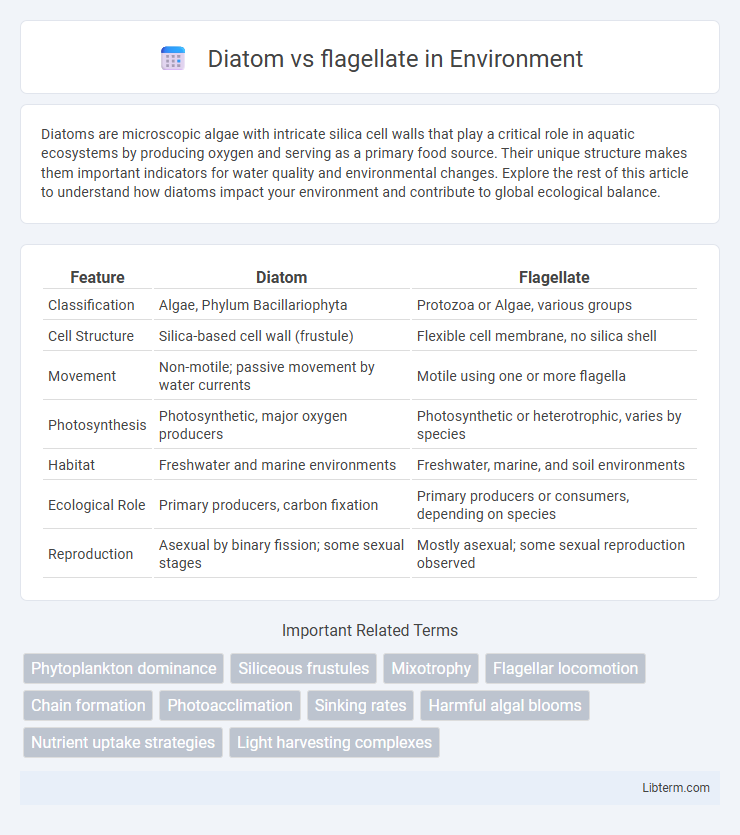Diatoms are microscopic algae with intricate silica cell walls that play a critical role in aquatic ecosystems by producing oxygen and serving as a primary food source. Their unique structure makes them important indicators for water quality and environmental changes. Explore the rest of this article to understand how diatoms impact your environment and contribute to global ecological balance.
Table of Comparison
| Feature | Diatom | Flagellate |
|---|---|---|
| Classification | Algae, Phylum Bacillariophyta | Protozoa or Algae, various groups |
| Cell Structure | Silica-based cell wall (frustule) | Flexible cell membrane, no silica shell |
| Movement | Non-motile; passive movement by water currents | Motile using one or more flagella |
| Photosynthesis | Photosynthetic, major oxygen producers | Photosynthetic or heterotrophic, varies by species |
| Habitat | Freshwater and marine environments | Freshwater, marine, and soil environments |
| Ecological Role | Primary producers, carbon fixation | Primary producers or consumers, depending on species |
| Reproduction | Asexual by binary fission; some sexual stages | Mostly asexual; some sexual reproduction observed |
Introduction to Diatoms and Flagellates
Diatoms are microscopic algae characterized by their silica-based cell walls forming intricate, glass-like frustules, playing a crucial role in aquatic ecosystems as primary producers. Flagellates are diverse protozoa or algae that use whip-like flagella for movement and feeding, often found in both freshwater and marine environments. Both diatoms and flagellates contribute significantly to the global carbon cycle and oxygen production through photosynthesis.
Morphological Differences
Diatoms possess rigid silica cell walls called frustules with intricate and symmetrical patterns, providing structural support and protection. Flagellates have flexible cell membranes and use one or more whip-like flagella for mobility, enabling them to swim efficiently. Unlike diatoms' fixed shape, flagellates often exhibit varied and sometimes asymmetrical forms due to their adaptable membrane structure.
Habitat and Distribution
Diatoms predominantly inhabit freshwater and marine environments, thriving in well-lit, nutrient-rich waters where they contribute significantly to primary production and carbon fixation. Flagellates exhibit a broader habitat range, occurring in freshwater, marine, and soil environments, often thriving in both aerobic and anaerobic conditions due to their motility and adaptability. While diatoms are mostly found attached to surfaces or suspended as plankton, flagellates can actively swim to optimal environments, influencing their distribution in diverse ecological niches worldwide.
Nutritional Strategies
Diatoms utilize photosynthesis as their primary nutritional strategy, relying on chlorophyll pigments to convert sunlight into energy, making them key contributors to marine and freshwater autotrophic productivity. Flagellates exhibit diverse nutritional modes, including photoautotrophy, heterotrophy, and mixotrophy, enabling them to adapt to varying environmental conditions by either photosynthesizing or ingesting organic matter. This nutritional flexibility in flagellates contrasts with the predominantly photoautotrophic diatoms, influencing their ecological roles and distribution in aquatic ecosystems.
Reproduction and Life Cycles
Diatoms reproduce primarily through asexual cell division, where each daughter cell inherits one half of the silica shell, leading to a gradual size reduction that triggers sexual reproduction to restore cell size. Flagellates display diverse reproductive strategies, including binary fission, multiple fission, and sexual reproduction, often involving the fusion of gametes or syngamy. The life cycles of diatoms typically alternate between vegetative growth and a sexual phase for size restoration, whereas flagellates exhibit more complex life cycles with stages adapted to their environmental conditions and nutritional modes.
Ecological Roles in Aquatic Systems
Diatoms contribute significantly to aquatic ecosystems by serving as primary producers, forming the base of the food web through photosynthesis and supporting diverse marine and freshwater food chains. Flagellates play a vital role in nutrient cycling and energy transfer by grazing on bacteria and smaller phytoplankton, often functioning as mixotrophs that combine photosynthesis with heterotrophic consumption. The complementary ecological functions of diatoms and flagellates sustain ecosystem productivity, regulate biogeochemical cycles, and influence carbon sequestration in aquatic environments.
Adaptations to Environmental Changes
Diatoms possess silica cell walls that provide protection and enable survival in fluctuating aquatic environments, while their ability to form resting spores aids in enduring adverse conditions. Flagellates use their whip-like flagella for motility, allowing them to seek optimal light and nutrient conditions rapidly in response to environmental changes. Both groups exhibit metabolic flexibility, with diatoms performing photosynthesis efficiently under variable light, and flagellates often switching between autotrophic and heterotrophic modes to adapt to nutrient availability.
Importance in the Food Web
Diatoms serve as a critical primary producer in aquatic food webs, converting sunlight into energy through photosynthesis and supporting a wide range of marine and freshwater organisms. Flagellates contribute by consuming bacteria and smaller plankton, recycling nutrients and providing an essential food source for higher trophic levels, including zooplankton and small fish. Their combined roles enhance nutrient cycling and energy transfer, maintaining ecosystem stability and productivity.
Applications in Research and Industry
Diatoms are extensively used in environmental monitoring and nanotechnology due to their silica cell walls with intricate nanopatterns, enabling advanced filtration and biosensing applications. Flagellates, with their motility and diverse metabolic pathways, are crucial in biofuel production and wastewater treatment research, enhancing biomass conversion efficiency. Both organisms serve as model systems in studying aquatic ecosystems and microbial physiology, driving innovations in bioprocess engineering and ecological assessment.
Summary: Key Differences and Similarities
Diatoms and flagellates are both diverse groups of unicellular algae important in aquatic ecosystems, with diatoms characterized by their silica cell walls forming intricate patterns, while flagellates typically possess one or more whip-like flagella for movement. Both serve as primary producers in marine and freshwater environments, contributing significantly to oxygen production and the food web, yet diatoms are predominantly photosynthetic, whereas flagellates can be mixotrophic, combining photosynthesis and heterotrophy. Key differences include diatoms' rigid, glass-like frustules versus flagellates' flexible cell coverings and motility mechanisms, while both exhibit adaptations for survival in varied environmental conditions.
Diatom Infographic

 libterm.com
libterm.com